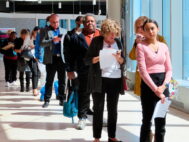U.S. job openings barely budged in October, coming in just below 7.7 million
U.S. job openings held at 7.7M in October as quits fell and layoffs rose, signaling a cooling labor market amid tariffs and Fed rate debates.
US job openings barely budged in August at 7.2 million
Job openings stayed at 7.23M in August as hiring slowed. Layoffs eased but quits fell amid Fed cuts, trade tensions, and shutdown risk.
US job openings slip in July, adding to evidence that the American labor market is cooling
Job openings slipped to 7.2M in July, down from 7.4M in June, signaling a cooling labor market as layoffs rose and quits held steady.
U.S. job openings dip to 7.4M as market cools
WASHINGTON (AP) — Employers posted 7.4 million job vacancies last month, a sign that the American job market continues to cool. The Labor Department reported Tuesday that job openings in June were down from 7.7 million in May and were about what forecasters had expected. The Job Openings and Labor Turnover Survey (JOLTS) showed […]
Wall Street drifts as Tesla drops and yields rise following economic updates
NEW YORK (AP) — U.S. stocks are drifting on Tuesday as Wall Street’s momentum slows after setting record highs in each of the last two days. The S&P 500 was 0.1% lower in morning trading and potentially on track for its first loss in four days. The Dow Jones Industrial Average was up by 153 points, or […]
US job openings in May hit 7.8 million in a continuing display of labor market resilience
WASHINGTON (AP) — U.S. job openings rose unexpectedly in May, a sign that the American labor market remains resilien t in the face of high borrowing costs and uncertainty over U.S. economic policy. U.S. employers posted 7.8 million vacancies in May, the Labor Department reported Tuesday, up from 7.4 million in April. Economists had expected a slight […]
Buc-ee’s hiring for first Virginia location opening in June
Buc-ee’s to open its first Virginia location in Rockingham County June 30, creating 200 jobs with wages from $18–$24/hour.
Va. job creation up in July, but filling jobs remains challenge
Total payroll employment in Virginia grew by 4,800 jobs in July, the Federal Reserve Bank of Richmond reported in its regional economic snapshot Friday, but some employers are having difficulty filling jobs. A U.S. Bureau of Labor Statistics survey released Tuesday said that the number of hires in Virginia in June dropped by 33,000 since […]
Lego breaks ground on $1B Chesterfield facility
The Lego Group broke ground Thursday on its $1 billion Chesterfield County manufacturing facility — launching the Danish toymaker’s first U.S. manufacturing plant and one of Virginia’s biggest economic development projects. The Billund, Denmark-based toy company known for its brightly colored plastic toy bricks and construction sets plans to hire 1,761 people to work at […]
Va. labor market stayed strong in February
Virginia’s labor market remained strong in February, although growth is slowing, according to employment data from the Federal Reserve Bank of Richmond. Virginia had a net gain of 3,200 jobs in February. The Virginia state government employment was previously 12,000 jobs below the February 2020 level, but the state government nearly halved that deficit last […]




















